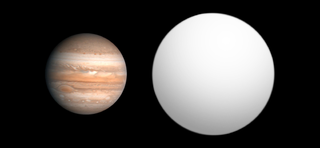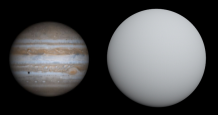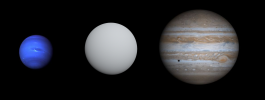
CoRoT was a space telescope mission which operated from 2006 to 2013. The mission's two objectives were to search for extrasolar planets with short orbital periods, particularly those of large terrestrial size, and to perform asteroseismology by measuring solar-like oscillations in stars. The mission was led by the French Space Agency (CNES) in conjunction with the European Space Agency (ESA) and other international partners.

CoRoT-2b is the second extrasolar planet to be detected by the French-led CoRoT mission, and orbits the star CoRoT-2 at a distance of 700 light years from Earth towards the constellation Aquila. Its discovery was announced on 20 December 2007. After its discovery via the transit method, its mass was confirmed via the radial velocity method.

WASP-8b is an exoplanet orbiting the star WASP-8A in the constellation of Sculptor. The star is similar to the Sun and forms a binary star with a red dwarf star (WASP-8B) of half the Sun's mass that orbits WASP-8A 4.5 arcseconds away. The system is 294 light-years away and is therefore located closer to Earth than many other star systems that are known to feature planets similar to WASP-8b. The planet and its parent star were discovered in the SuperWASP batch -6b to -15b. On 1 April 2008, Dr. Don Pollacco of Queen's University Belfast announced them at the RAS National Astronomy Meeting.

WASP-8 is a binary star system 294 light-years away. The star system is much younger than the Sun at 300 million to 1.2 billion years age, and is heavily enriched in heavy elements, having nearly twice the concentration of iron compared to the Sun.

CoRoT-3b is a brown dwarf or massive extrasolar planet with a mass 21.66 times that of Jupiter. The object orbits an F-type star in the constellation of Aquila. The orbit is circular and takes 4.2568 days to complete. It was discovered by the French-led CoRoT mission which detected the dimming of the parent star's light as CoRoT-3b passes in front of it.

HAT-P-8b is an extrasolar planet located approximately 720 light years away in the constellation of Pegasus, orbiting the 10th magnitude star GSC 02757-01152. This planet was discovered by transit on December 5, 2008. Despite the designation as HAT-P-8b, it is the 11th planet discovered by the HATNet Project. The mass of the planet is 50% more than Jupiter while the radius is also 50% more than Jupiter. The mass of this planet is exact since the inclination of the orbit is known, typical for transiting planets. This is a so-called “hot Jupiter” because this Jupiter-like gas giant planet orbits in a really close torch orbit around the star, making this planet extremely hot. The distance from the star is roughly 20 times smaller than that of Earth from the Sun, which places the planet roughly 8 times closer to its star than Mercury is from the Sun. The “year” on this planet lasts only 3 days, 1 hour, 49 minutes, and 54 seconds, compared with Earth's 365 days, 6 hours, 9 minutes, and 10 seconds in a sidereal year.

CoRoT-7b is an exoplanet orbiting the star CoRoT-7 in the constellation of Monoceros, 489 light-years from Earth. It was first detected photometrically by the French-led CoRoT mission and reported in February 2009. Until the announcement of Kepler-10b in January 2011, it was the smallest exoplanet to have its diameter measured, at 1.58 times that of the Earth and the first potential extrasolar terrestrial planet to be found. The exoplanet has a very short orbital period, revolving around its host star in about 20 hours.
CoRoT-2 is a yellow dwarf main sequence star a little cooler than the Sun. This star is located approximately 700 light-years away in the constellation of Aquila. The apparent magnitude of this star is 12, which means it is not visible to the naked eye but can be seen with a medium-sized amateur telescope on a clear dark night.
CoRoT-6 is a magnitude 13.9 star located in the Ophiuchus constellation.
CoRoT-13b is a transiting exoplanet found by the CoRoT space telescope on 12 July 2010.

CoRoT-16b is a transiting exoplanet orbiting the G or K type main sequence star CoRoT-16 2,433 light years away in the southern constellation Scutum. The planet was discovered in June 2011 by the French-led CoRoT mission.
CoRoT-8 is a star in the constellation Aquila at a distance of about 1239 light-years from us. At least one planet revolves around the star.










